Marrying Vega and Zen: The AMD Ryzen 5 2400G Review
by Ian Cutress on February 12, 2018 9:00 AM ESTBenchmarking Performance: CPU Rendering Tests
Rendering tests are a long-time favorite of reviewers and benchmarkers, as the code used by rendering packages is usually highly optimized to squeeze every little bit of performance out. Sometimes rendering programs end up being heavily memory dependent as well - when you have that many threads flying about with a ton of data, having low latency memory can be key to everything. Here we take a few of the usual rendering packages under Windows 10, as well as a few new interesting benchmarks.
All of our benchmark results can also be found in our benchmark engine, Bench.
Corona 1.3: link
Corona is a standalone package designed to assist software like 3ds Max and Maya with photorealism via ray tracing. It's simple - shoot rays, get pixels. OK, it's more complicated than that, but the benchmark renders a fixed scene six times and offers results in terms of time and rays per second. The official benchmark tables list user submitted results in terms of time, however I feel rays per second is a better metric (in general, scores where higher is better seem to be easier to explain anyway). Corona likes to pile on the threads, so the results end up being very staggered based on thread count.

Blender 2.78: link
For a render that has been around for what seems like ages, Blender is still a highly popular tool. We managed to wrap up a standard workload into the February 5 nightly build of Blender and measure the time it takes to render the first frame of the scene. Being one of the bigger open source tools out there, it means both AMD and Intel work actively to help improve the codebase, for better or for worse on their own/each other's microarchitecture.
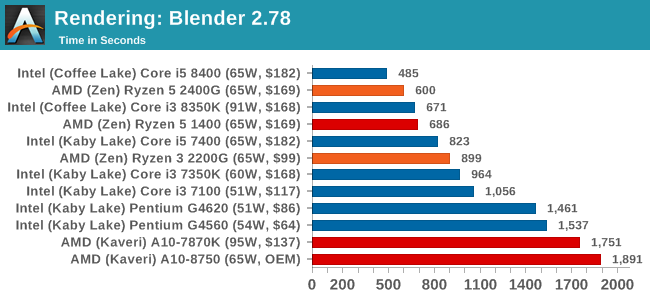
LuxMark v3.1: Link
As a synthetic, LuxMark might come across as somewhat arbitrary as a renderer, given that it's mainly used to test GPUs, but it does offer both an OpenCL and a standard C++ mode. In this instance, aside from seeing the comparison in each coding mode for cores and IPC, we also get to see the difference in performance moving from a C++ based code-stack to an OpenCL one with a CPU as the main host.
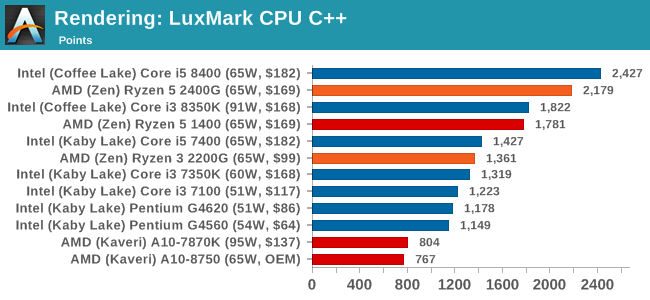
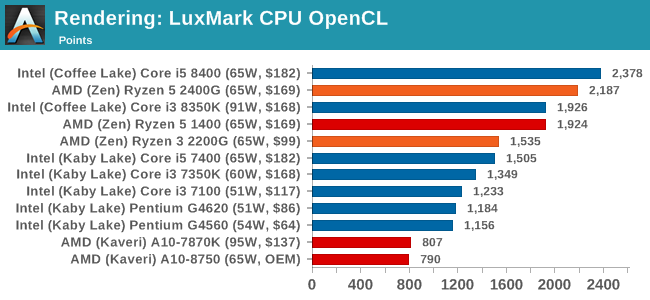
POV-Ray 3.7.1b4: link
Another regular benchmark in most suites, POV-Ray is another ray-tracer but has been around for many years. It just so happens that during the run up to AMD's Ryzen launch, the code base started to get active again with developers making changes to the code and pushing out updates. Our version and benchmarking started just before that was happening, but given time we will see where the POV-Ray code ends up and adjust in due course.
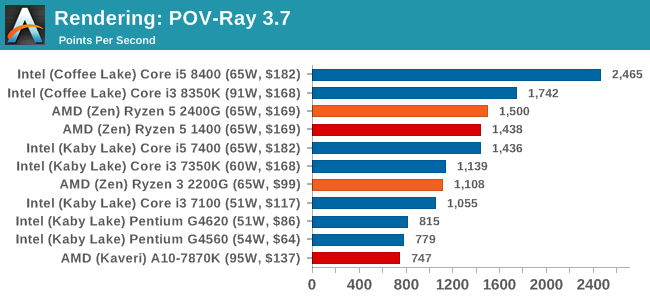
Cinebench R15: link
The latest version of CineBench has also become one of those 'used everywhere' benchmarks, particularly as an indicator of single thread performance. High IPC and high frequency gives performance in ST, whereas having good scaling and many cores is where the MT test wins out.
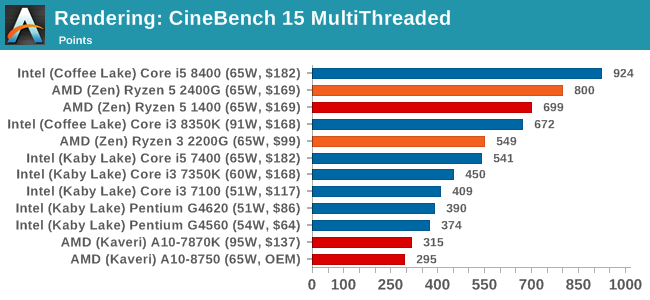

Conclusions on Rendering: It is clear from these graphs that most rendering tools require full cores, rather than multiple threads, to get best performance. The exception is Cinebench.










177 Comments
View All Comments
Pork@III - Monday, February 12, 2018 - link
I think I have to make it clear. The quoted processor(Core i7-8809G) will crush the Ryzen 5 2400G, but some other cheaper models in its series will perform better, just the superiority will be, not so great in the test results, but there will be such in terms of the price ratio / productivity.Manch - Monday, February 12, 2018 - link
Stfu trollHolliday75 - Monday, February 12, 2018 - link
I don't know any idiots that would buy that CPU to build a low end gaming rig that can still handle facebook and Office products. Worthless comment.lilmoe - Monday, February 12, 2018 - link
Welcome back AMD :)I'll be holding on to my Haswell for another year or two. Fingers crossed for a 7nm quad core (6 core maybe???) with HT and Vega 16 (or 18) APU. When that's out, I'll be upgrading promptly, both laptop and desktop machines.
REALLY excited.
ToTTenTranz - Monday, February 12, 2018 - link
Thanks for the review!What are the system specs for the GT 1030 results? I can't find them in the review..
thevoiceofreason - Monday, February 12, 2018 - link
They need to release a variant with halved CPU clocks and TDP for HTPC use.Manch - Monday, February 12, 2018 - link
Cant you just undervolt and downclock it?lilmoe - Monday, February 12, 2018 - link
You don't need to half CPU clocks to reach half the TDP, you can get 70-80% by halfing TDP. That would be very appealing actually for 35-40 watts.Manch - Tuesday, February 13, 2018 - link
It's funny you said that bc you're spot on in regards to the GE variants!jjj - Monday, February 12, 2018 - link
There was a leak over the weekend about GE SKUs at 35W and lower clocks.